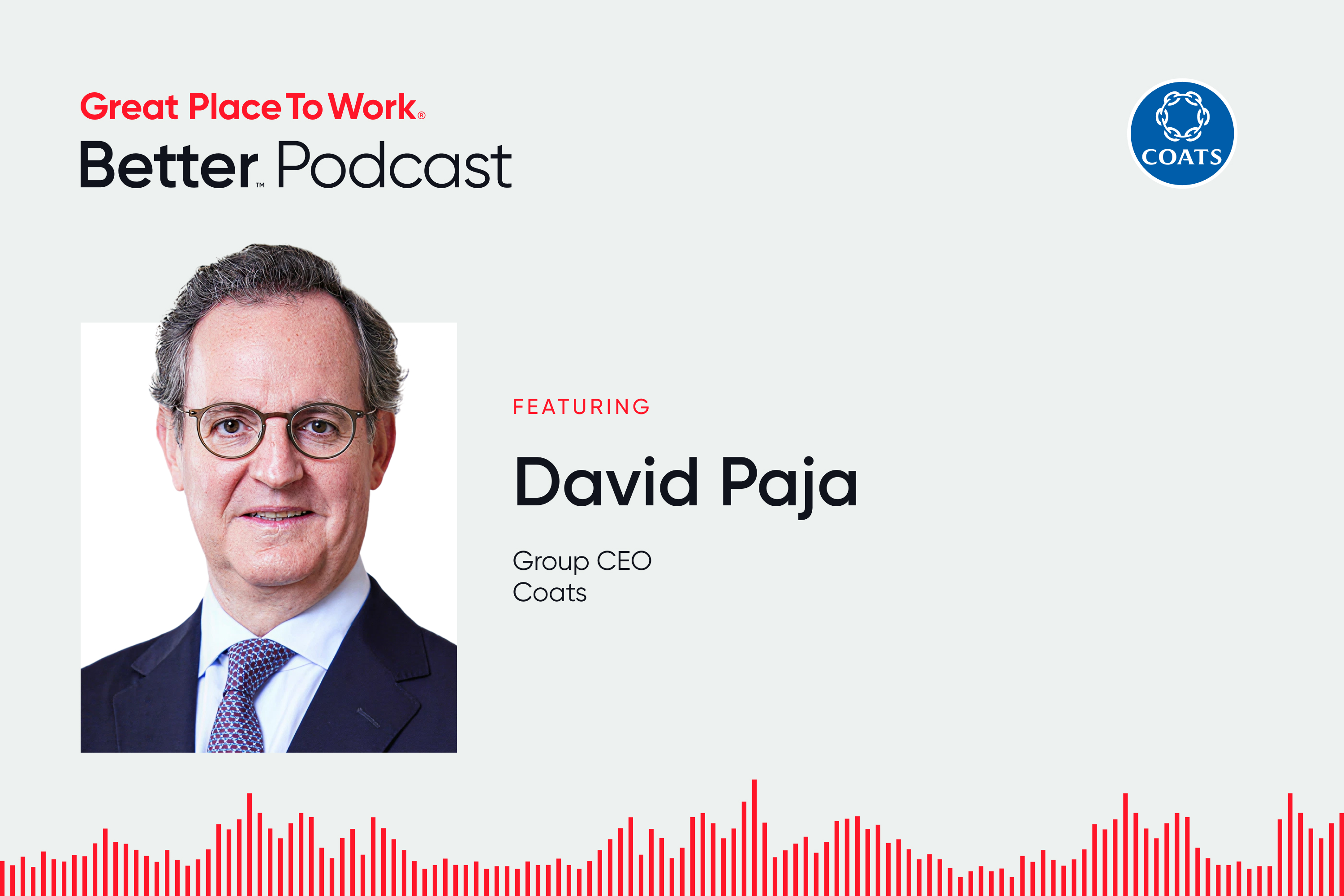Leadership & Management, Managers
Knowing how to lead and manage your people through upheaval is vital to the success of an organization. It’s also one of the biggest challenges facing leaders in a rapidly evolving workplace.
Over the past five years, leaders have had to steer their people through many challenges — from COVID to hybrid work to the introduction of generative AI. If teams don’t learn how to do things differently, morale and the business could suffer.
Trust is at the heart of every great company, and when change management practices are centered around that value, employees are more likely to be on board.
Leaders have a key role in guiding their people through change thoughtfully. The result of effective change management strategies for businesses includes reduced costs, boosted efficiency, and improved employee engagement.
What is leadership and change management and why does it matter?
Leadership and change management is the deliberate coordination of people, processes, and culture to adapt to new realities, processes, and technologies. This could include mergers and acquisitions, adopting machine learning, or launching new products. Change management is a structured process that typically involves project managers and people managers working together to guide employees through new workflows.
A critical component of successful change management is change leadership. It’s a people-centric approach that sees change as an opportunity for growth, rather than another project to be managed. At its core, change leadership is about setting the tone and fostering a culture of embracing change.
Benefits of change management
When done effectively, change management leadership builds resilience, trust, and efficiency. The benefits of change management for businesses include improved adaptability, enhanced employee engagement, and increased overall productivity:
Cost savings — A well-structured and executed change management plan can lead to a more efficient use of resources, reduced delays, and smoother transitions, all of which contribute to lower overall costs.
Boosted operational efficiency — Leading through times of change boosts operational efficiency by improving communication and easing resistance to implementing new methods or processes.
Greater employee engagement — Strong leadership has a direct impact on employee engagement and loyalty. When employees understand the rationale behind changes and feel supported, they are more likely to be open to innovation and be committed to the success of the process.
Stronger business performance — When employees are on board and projects are running efficiently, companies can see an increased ROI, which translates into better financial performance.
Increased change readiness — When employees experience well-managed change, they build confidence in the process. Over time, this fosters a more positive attitude toward future changes and reduces resistance — making the organization more adaptable and resilient.
Practical change management strategies for leaders
Start with a clear vision and measurable goals — Employees want to know how they fit into the future of an organization, especially in times of change. When leaders can confidently convey why change is happening and have a clear view of success, your people are 51% more likely to adapt quickly to change.
The vision for change should outline the desired future state and how it aligns with your company goals and a means for tracking and measuring their success.
Communicate early, often, and transparently — While change is messy, the cost of staying silent is riskier. Great Place To Work® has identified nine high-trust leadership behaviors that can build or break trust in the workplace. Speaking is one of them.
For leaders, that means sharing information clearly, frequently, and transparently. Establish multiple communication channels, such as “ask us anything” forums, and provide opportunities for two-way dialogue.
Empower managers as change champions — At Hilcorp, a company recognized on the Fortune 100 Best Companies to Work For® List, empowering managers is a cornerstone of its change strategy. During a period of rapid expansion — including three acquisitions totaling $3.5 billion — Hilcorp leaned into its flat organizational structure and culture of ownership to support mid-level leaders.
With only five layers from CEO to field operator, decision-making is fast and inclusive, giving managers the autonomy and clarity they need to lead through change. Leaders are expected to model transparency and accountability, reinforcing new behaviors and ensuring alignment across newly integrated teams.
Listen to employee feedback continuously — Hilcorp’s success in integrating new teams stems from more than just operational rigor — it’s rooted in a decade-long commitment to employee listening.
Using tools like the Trust Index™ Survey, the company tracks how acquisition hires are performing and feeling, and uses that data to guide leadership decisions. Leaders host regular town halls and pulse surveys to surface concerns early and adjust course as needed.
This culture of “say-do” consistency — delivering on what they promise — has helped build trust and reduce resistance during transitions. As Hilcorp puts it, “A company of owners will outperform a company of employees any day of the week.”
Common challenges leaders face during change management
Even as leaders have moved from a traditional top-down approach to a more visionary and collaborative style of management, leading through times of change can be difficult.
Here are some frequent change management challenges leaders encounter and examples of how to overcome resistance through strong change leadership.
Lack of trust among employees — Edelman’s latest “Trust Barometer” shows growing resistance to innovation. The culprit? Lack of trust. Without trust, your company will resist innovation.
As the technology promises to cut costs and boost efficiency, companies that remain committed to their people are the ones poised to benefit. A high-trust culture, modeled on credibility, respect, and fairness, is the cornerstone of that success.
Trek Bicycle took measures to ensure that introducing AI to improve workflows was centered around credibility, respect, and fairness. A dedicated team interviewed employees at all levels of the business on how AI might improve their work environment. From there, the team presented Trek’s senior managers with a list of nearly 40 concrete use-cases for AI, while prioritizing employees’ well-being and input.
Poor communication across teams — We’ve already highlighted that speaking is a high-trust behavior. But when information isn’t shared clearly and consistently, confusion, resistance, and the failure of a project are a likely result.
A period of disruption is the right time to build trust in the workplace by listening to your employees. Give leaders the tools they need to communicate transparently about change management processes. Use multiple communication channels to reach all people. Communicate often, be transparent, and maintain clear messaging across teams.
When Hilton, No. 1 on the Fortune 100 Best Companies to Work For™ List, made the difficult decision to lay off employees during the pandemic, the company made sure that leaders kept their employees informed throughout the difficult layoff process.
Resistance to change due to fear or uncertainty — Resistance to change due to fear and uncertainty is a common human reaction. Employees may worry that changes will disrupt their ways of working, team structure, or responsibilities.
Effective change management requires leaders to understand and address the root cause of uncertainty and foster a more supportive environment for change.
BVI Medical was challenged with standardizing and automating their HR model. To ease the change management process, the MedTech firm provided training and explained the value of change, while celebrating success stories. The result meant their HR team could spend less time on admin and had more time on developing and coaching their people.
Burnout from change overload — Dizzying organizational change can lead to employee burnout, due to increased stress, limited control of their environment, lack of clarity, and work–life imbalance.
While burnout is busy taking a toll on employees’ health and happiness, it’s also quietly eating away at a company’s ability to achieve its objectives. Especially during times of change, organizations should prioritize employee health and support their teams to prevent burnout.
One example is Wellstar Health System. The health care organization established a dedicated wellness team to improve employees’ experience with wellness rooms for employees to recharge and a program that trains leaders on how to improve wellness across their teams.
How to build a resilient culture during change
Effective change management leadership is not just about process; it’s also about building a resilient culture. “Inspiring” — one of the nine high-trust leadership behaviors — is all about helping employees see how they fit into the bigger picture and how their work makes a difference.
- Model behaviors that reinforce resilience and adaptability — Resiliency and an openness to change start at the top.
DHL Supply Chain trained more than 9,000 managers to lead with purpose through a two-day program designed to help managers develop the skills to communicate strategy and business priorities. Leaders say it helped them understand how to make topics accessible and relevant to their teams. - Recognize and celebrate small wins along the journey — The benefits of change management become more real when there are numbers to show your impact.
Stryker, a biotechnology manufacturer, calculated that it has impacted over 130 million patients annually using a methodology developed by a cross-functional team of experts — a figure that fills employees with pride!
- Reinforce core company values through every stage of change — When companies live up to their values, that builds trust
At Vertex Pharmaceuticals, a bell-ringing ceremony is held to celebrate important milestones in the disease treatment development. Employees can see firsthand the impact of their work on patients’ lives, and the ceremony serves to connect employees with the deeper purpose of their work.
The future of leadership and change management
Maintaining a competitive advantage means leaders need to stay up to date with the latest emerging trends impacting change management practices.
Leading hybrid and remote teams through change — How do you engage remote and hybrid teams while leading organizational change? Communication, a clear vision, and focus on relationship-building are key.
Lead the way by pushing for conversations to be on a less formal forum than email. For Lex Machina, that means talking on GitHub or Slack, where important conversations could still take place. The company also encourages people managers to discuss problems publicly, so team members felt comfortable enough to be vulnerable and ask for help.
Atlassian leads its people by making a commitment to a digital-first culture, with a default for virtual meetings and a greater emphasis on asynchronous communication. This ensures hybrid or remote teams don’t feel at a disadvantage.
Using AI and data analytics to guide change initiatives — AI and data analytics can be invaluable tools in assessing the impact of change management:
- Analyze existing data to predict the potential impact of change on various departments and teams
- Identify trends related to resisting change and tailor communication to address concerns and increase buy-in
- Real-time feedback loops help identify areas where employee communication can be improved to ensure the success of change strategies
Organizations can support leaders to cut costs and boost efficiency by training their workforce in AI. At Ally Financial, quarterly “AI Days” offer an opportunity for employees to hear from expert speakers and observe live demos of AI tools and their capabilities.
Prioritizing mental health and well-being during transitions — Prioritize the well-being and care of team members during periods of change.
Some key practices that managers can use to care for their people include:
- Acknowledging the emotional burden employees may be facing and sending a powerful message that leaders are there to support them
- Connecting employees with coaches, experts, and counselors to guide them in developing strategies and skills that support their situation.
- Fostering an environment of ongoing development and learning through mentorship and open communication
- Providing a sense of control and purpose by allowing employees a sense of autonomy while linking their role to the outcomes of the organization.
Download the “Well-being at Work: Fostering a Healthy Work Climate For All” report to explore how companies are boosting retention, productivity, and belonging through a healthy work climate.
Empower your organization through effective change management leadership
Whether an organization is navigating a merger or introducing AI tools to revolutionize workflows, strong change management leadership is required to steer a business towards growth.
When done thoughtfully, the benefits for organizations include reduced cost, improved efficiency, and increased employee trust.
Leaders play a key role in centering change around culture-first strategies, transparency, and considering the needs and concerns of their people. That starts with listening.
Regular surveys provide leaders with real-time insights needed to guide successful, trust-based change initiatives. Great Place To Work’s employee survey solutions can empower organizations to navigate change with confidence and build a resilient, high-trust culture.
Explore our employee survey solutions today.
Turn culture insights into business wins
Let the Trust Index™ Survey reveal your workplace’s hidden strengths and areas for growth. Start transforming today.










